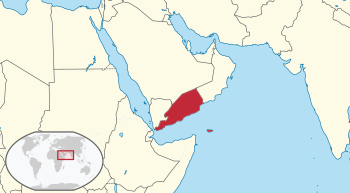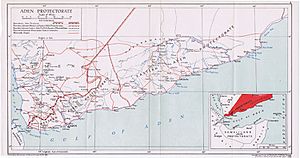Aden Protectorate facts for kids
Quick facts for kids
Aden Protectorate
محمية عدن
|
|||||||||||||||||
|---|---|---|---|---|---|---|---|---|---|---|---|---|---|---|---|---|---|
| 1872–1963 | |||||||||||||||||

Location of the Aden Protectorate on the Arabian Peninsula.
|
|||||||||||||||||
| Status | Self-ruling sultanates, emirates and sheikdoms under British protection | ||||||||||||||||
| Capital | Various | ||||||||||||||||
| Common languages | Arabic Persian English Ottoman Turkish |
||||||||||||||||
| Religion | Islam Judaism Christianity |
||||||||||||||||
| Demonym(s) | Adeni | ||||||||||||||||
| History | |||||||||||||||||
|
• Initial treaty
|
1872 | ||||||||||||||||
| 11 February 1959 | |||||||||||||||||
|
• Disestablished
|
18 January 1963 | ||||||||||||||||
| Currency | Thaler, Rupee | ||||||||||||||||
|
|||||||||||||||||
| Today part of | Yemen | ||||||||||||||||
The Aden Protectorate (Arabic: محمية عدن Maḥmiyyat ‘Adan) was a group of small states in South Arabia. These states were under the protection of the United Kingdom. The protectorate grew in the area behind the port city of Aden. This happened after the British took control of Aden in 1839. The Aden Protectorate lasted until the 1960s.
In 1940, it was split into two parts for easier management: the Western Protectorate and the Eastern Protectorate. Today, this land is part of the country of Yemen. The rulers of these states remained in charge of their own areas. They still used their own flags and made their own decisions. This was different from places like Aden Colony, where the British monarch was the head of state.
Contents
History of the Protectorate
Early Agreements
The Aden Protectorate started with informal agreements. The British made deals with nine tribes living near the port city of Aden. These tribes included:
Britain wanted to protect the important port of Aden. This port was managed by British India at the time. From 1874, the Ottoman Empire (which ruled Yemen to the north) quietly agreed to these protection deals. These areas became known as the "Nine Tribes."
Formal Protection Treaties
Britain began signing formal treaties to protect these states. The first major treaty was with the Mahra Sultanate of Qishn and Socotra in 1886. Over time, Britain signed more than 30 main treaties. The last one was signed in 1954. These treaties created the Aden Protectorate. It stretched far east of Aden, reaching Hadhramaut. It included almost all the land that would later become South Yemen. The only part not included was the port and surrounding area of Aden itself.
Aden and its harbor were fully under British rule. This area was known by different names over the years, like Aden Settlement and Aden Colony. In return for British protection, the rulers of the Protectorate states agreed not to make treaties with other foreign powers. They also promised not to give away any land to them.
In 1917, the control of the Aden Protectorate moved from the Government of India to the British Foreign Office. The protectorate was then divided into two parts for easier management: the Eastern Protectorate and the Western Protectorate. Each had a British advisor.
In 1928, the British set up Aden Command, led by the Royal Air Force. Its job was to keep the Protectorate safe.
States in the Protectorate
The number and borders of the states in the protectorate changed over time. Some states, like the Mahra Sultanate, hardly had any working government.
The Aden Colony and some islands like Perim were not part of the protectorate.
Eastern Protectorate
The Eastern Protectorate was a large area (about 230,000 square kilometers). It included these states, mostly in Hadhramaut:
Western Protectorate
The Western Protectorate was smaller (about 55,000 square kilometers). It included:
- Alawi
- Aqrabi
- Audhali
- Beihan
- Dathina
- Dhala
- Qutaibi (part of Dhala)
- Fadhli
- Haushabi
- Lahej
- Lower Aulaqi
- Lower Yafa
- Shaib
- Upper Aulaqi Sheikhdom
- Upper Aulaqi Sultanate
- Upper Yafa Sultanate and its five sheikhdoms:
Advisory Treaties
In 1938, Britain signed an advisory treaty with the Qu'aiti sultan. Over the next two decades, they signed similar treaties with twelve other states in the protectorate. These states were:
- Eastern Protectorate States
- Kathiri
- Mahra
- Qu'aiti
- Wahidi Balhaf
- Western Protectorate States
- Audhali
- Beihan
- Dhala
- Haushabi
- Fadhli
- Lahej
- Lower Aulaqi
- Lower Yafa
- Upper Aulaqi Sheikhdom
These agreements allowed Britain to place a "Resident Advisor" in these states. This gave Britain more control over their local affairs. This made the leaders' positions very stable, but sometimes it also led to problems. Sometimes, the British used force to make sure their rules were followed by tribes that didn't agree. People started to feel that British protection was holding back progress. This feeling grew stronger as news of Arab nationalism spread through new transistor radios.
Challenges to British Control
King Ahmad bin Yahya of the Mutawakkilite Kingdom of Yemen to the north also challenged British control. He did not accept British rule in South Arabia. He wanted to create a single, unified "Greater Yemen." In the late 1940s and early 1950s, Yemen had several small fights along the border. This border was set by a 1914 agreement between Britain and the Ottoman Empire.
In 1950, Kennedy Trevaskis, a British advisor, suggested that the protectorate states form two federations. King Ahmad bin Yahya saw this as a threat. He feared that successful federations in the protectorates would encourage people in Yemen who were unhappy with his rule. To stop this, King Ahmad increased efforts to weaken British control. In the mid-1950s, Yemen supported several revolts by unhappy tribes against the protectorate states.
At first, Yemen's appeal in the protectorate was limited. But as Yemen grew closer to Egypt's popular Arab nationalist president, Gamal Abdel Nasser, and formed the United Arab States, its ideas became more attractive.
Federation and the End of the Protectorate
Aden was important to Britain because it was a link to British India. After Britain lost most of its colonies from 1945 and faced the Suez Crisis in 1956, Aden became even more valuable. It was a key port for accessing oil from the Middle East. It was also chosen as the new location for Britain's Middle East military command.
Pressure from nationalists pushed the rulers of the Aden Protectorate states to try forming a federation again. On February 11, 1959, six states signed an agreement to create the Federation of Arab Emirates of the South. Over the next three years, nine more states joined. On January 18, 1963, Aden Colony joined the federation. This created the new Federation of South Arabia. At the same time, the states (mostly in the east) that did not join the federation became the Protectorate of South Arabia. This marked the end of the Aden Protectorate.
Aden Emergency
On December 10, 1963, a state of emergency was declared in the former protectorate and the new State of Aden. This emergency was largely caused by a wave of Arab nationalism spreading across the Arabian Peninsula. This idea came mostly from the Egyptian leader Gamel Abdel Nasser.
By 1963, groups fighting against British rule started to form. There were two main rival groups: the Egyptian-supported National Liberation Front (NLF) and the Front for the Liberation of Occupied South Yemen (FLOSY). They attacked each other as well as the British.
By 1965, the RAF station (RAF Khormaksar) had nine squadrons of aircraft. These included transport helicopters and Hawker Hunter planes used for ground attacks. The army called on these planes to strike enemy positions.
The Battle of Crater made Lt-Col Colin Campbell Mitchell famous. On June 20, 1967, there was a rebellion in the South Arabian Federation Army, which spread to the police. The British managed to restore order, mainly thanks to the efforts of the 1st Battalion Argyll and Sutherland Highlanders, led by Lt-Col Mitchell.
However, deadly attacks by the NLF against British forces continued. The British left Aden by the end of November 1967. This was earlier than planned and without an agreement on who would govern next. The NLF then took power.
Images for kids
See Also
- Aden Emergency
- History of Aden
- History of Yemen
- List of British protectorates
- List of former British protectorates
- South Arabia








